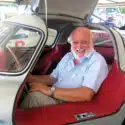Radio Ga-Ga, but Michele Prevails
In his book, designer Tony Southgate recalls how Michele Alboreto overcame electronic failure in a Ferrari at Sebring
Tony Southgate’s long-awaited autobiography – From Drawing Board to Chequered Flag – tops my current list of books not to miss. Tony has always been one of the most accomplished, friendly and cheerful of design engineers, a combination of attributes quite rare in my experience. His frontline career spanned almost five decades, designing single-seater racing cars for Lola, Brabham, Eagle, BRM, Shadow, Lotus, Arrows and Theodore, and sports-prototypes for Ford, Jaguar, Toyota, Ferrari, Nissan and Audi. Cars grown from this versatile designer’s drawing board won a dazzling triple-crown of pinnacle events – the Monaco Grand Prix, the Indianapolis 500 and the Le Mans 24 Hours.
Of all his assignments, Tony seems especially proud of his three-year period – 1994-96 – with Ferrari, perfecting and race-engineering its rakish 333SP Spider customer cars. His first 333SP project meeting with Luca di Montezemolo was evidently dominated by the stylish dynamo seeking Tony’s opinion on what engine configuration Ferrari should be using in Formula 1. Tony recalls: “Ferrari was still running a V12, but the quick opposition were now using V10s. I told him that, as a chassis designer, I would prefer the more compact V10 because it would be shorter, lighter and easier to package, and would use a little less fuel. OK, it would have a little less horsepower, but then it would have more torque. Montezemolo’s response was ‘All designers say that!’ Obviously it was not what he had hoped I would say…” So Ferrari V12 fans – here’s one you can blame.
But at Sebring in 1995 Tony looked after Andy Evans’s Scandia Motorsport-run 333SPs, which finished first and fourth in the Floridan 12 Hours to record Ferrari’s first victory in the American classic since 1972. The fourth-placed car was driven by Michele Alboreto, Mauro Baldi and Eric van der Poele. Michele started the long race from pole position but almost immediately Tony and the pitcrew realised they had lost radio contact with him. In fact his electronic dash had failed, so the Italian was flying blind. By that IMSA period in Sebring’s history, pit-to-car radio had become such standard practice that there was no provision for old-style board signalling from the pitwall. Any team requiring such archaic communication had to set up a signalling post on the outside of the circuit, opposite the pits. The Scandia guys rushed across there, but the excommunicated driver plainly had no idea what to do, nor where to look.
Yet, as Tony writes: “Michele came in within one lap of the correct fuel window, I explained about our new signalling system, he told me about the dash failure, and off he went. Later, the race was red-flagged for more than an hour because of a heavy thunderstorm. I asked Michele how on earth he had known when to come in for that first and very important fuel stop. He told me that he had waited until Wayne Taylor, driving the quick new Riley & Scott Mk3 car, went to the pits. He knew that it and the Ferrari were pretty much equal on fuel consumption. It had been the simplest thing for him just to follow Taylor, and I wondered why I had been so worried in the pitlane…”
Alboreto’s frontline Formula 1 career with Ferrari had started well in 1984 when he became the first Italian driver to be engaged by the team in more than 10 years. He won the 1984 Belgian GP and both the 1985 Canadian and German races. But in his subsequent three years with Ferrari this intelligent driver, from a relatively humble background, became branded as a whinger. I recall some antipathy between him and ‘Doc’ Postlethwaite, Harvey praising team-mates Stefan Johansson or Gerhard Berger before referring to Alboreto simply as “that other bloke”.
But he later found a comfy berth with Reinhold Joest’s endurance racing team. He won Le Mans in 1997 with Johansson and Tom Kristensen in their TWR-Porsche WSC-95, and subsequently with Audi Sport won the Sebring 12 Hours, co-driving an Audi R8 with Dindo Capello and Laurent Aïello. It was soon after, during pre-Le Mans testing at the gloomy Lausitzring, that he crashed following a rear tyre failure, and was killed.
I vividly recall how much he had enjoyed driving an Auto Union at the Festival of Speed, sitting in the car at the top of the hill, tittering with laughter as he explained: “I come up da ’ill looking underneaz da steering wheel rim. Ha – I drive like’a my granmuzza…!” Nice man. Which makes two of them.

